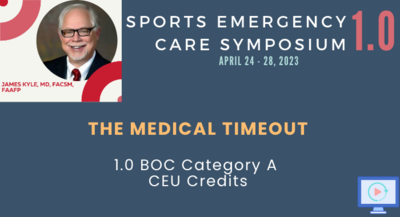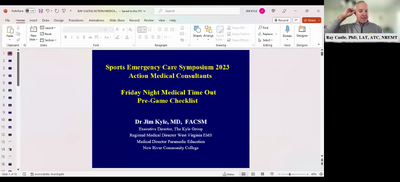Course Info (Description; Learning Objectives; Practice Gap; Clinical Bottom Line; Summary Conclusions)
Course Description:
All great professionals know being prepared is vital to achieving success. Whether it’s in business, academics, medicine, or sports, many of us run through at least a mental checklist before we engage in activity. It’s within that preparation that we find what is needed, how it should be implemented, and what to do if everything we’ve planned for doesn’t come to fruition. Those who are truly prepared to take the time to verbalize and record those thoughts in an effort to get others moving in a similar direction.
The Friday Night Medical Time Out is designed to prepare Emergency Medical Technicians, Paramedics, Team Physicians, Athletic Trainers, and anyone designated as responsible for the medical well-being of athletes or spectators on game day to simply be aware, prepared, and educated. Communication between these individuals can make the difference between a positive outcome and a negative experience should an injury or incident occur. Following the Friday Night Medical Time Out procedure reduces and in most cases eliminates chaos and confusion because these professionals simply took the time to be prepared.
BOC Domains of Athletic Training:
-
Domain I - Risk Reduction, Wellness, and Health Literacy
-
Domain Ill - Critical Incident Management
-
Domain V - Healthcare Administration and Professional Responsibility
Upon completion of this course, participants will be able to:
- Review Checklist for Pre-game Medical Time Out
- Discuss the need for documentation of Game Day sideline equipment
- Review possible causes of Athlete Collapse and key components of the initial assessment
Practice Gap:
Despite the potential for medical emergencies during sporting events, many athletic trainers and healthcare providers may not be adequately prepared to handle such situations. There is a need for standardized protocols and checklists, such as the Review Checklist for Pre-game Medical Time Out, to ensure that all necessary precautions are taken before the game starts. Additionally, proper documentation of Game Day sideline equipment can help streamline the initial assessment of a collapsed athlete. Finally, providers should be familiar with the key components of the initial assessment and possible causes of Athlete Collapse to be prepared to handle any emergency situation that may arise. Addressing these preparation gaps can help ensure athletes' safety and well-being during sporting events.
Clinical Bottom Line:
It is critical that all stakeholders are prepared for potential medical emergencies during sporting events. The use of a comprehensive Review Checklist for Pre-game Medical Time Out can help ensure that all necessary precautions are taken before the game starts. Additionally, proper documentation of Game Day sideline equipment can help streamline the initial assessment of a collapsed athlete. Finally, it is crucial to review possible causes of Athlete Collapse and be familiar with the key components of the initial assessment to be prepared to handle any emergency situation that may arise. By following these recommendations, medical and non-medical professionals can help ensure the safety and well-being of athletes during sporting events.
Summary Conclusions:
- The Medical Time Out is vital for preparing athletic trainers and healthcare providers for potential medical emergencies during sporting events.
- Standardized protocols and checklists, such as the Review Checklist for Pre-game Medical Time Out, can help ensure that all necessary precautions are taken before the game starts.
- Proper documentation of Game Day sideline equipment can help streamline the initial assessment of a collapsed athlete and reduce chaos and confusion.
- Providers should be familiar with the key components of the initial assessment and possible causes of Athlete Collapse to be prepared to handle any emergency situation that may arise.
- By following these recommendations and addressing gaps in preparation, medical and non-medical professionals can help ensure the safety and well-being of athletes during sporting events.


